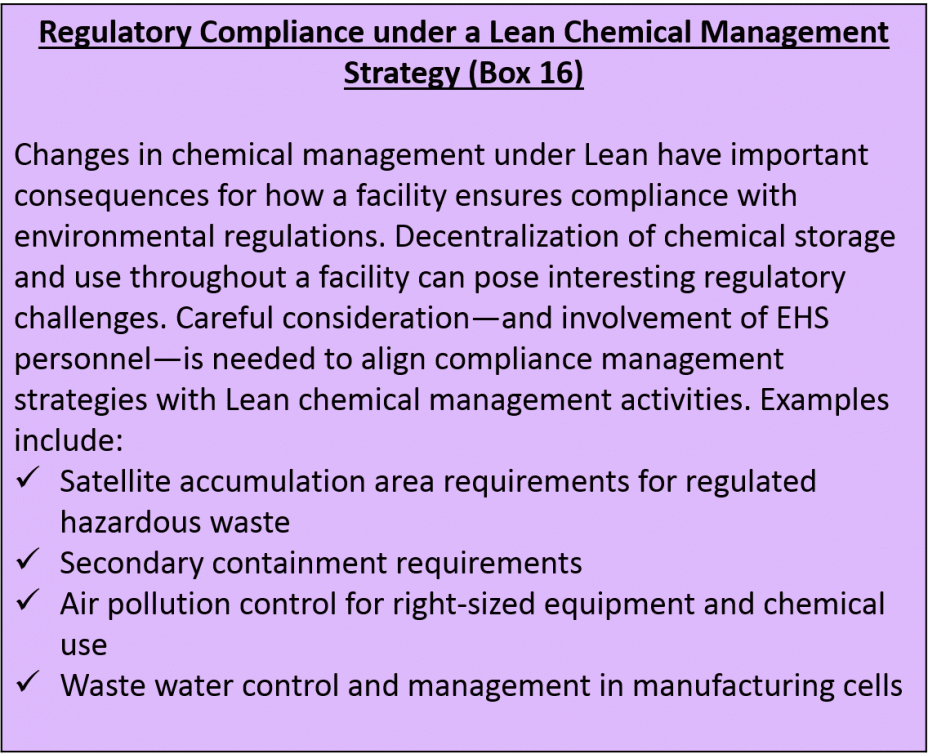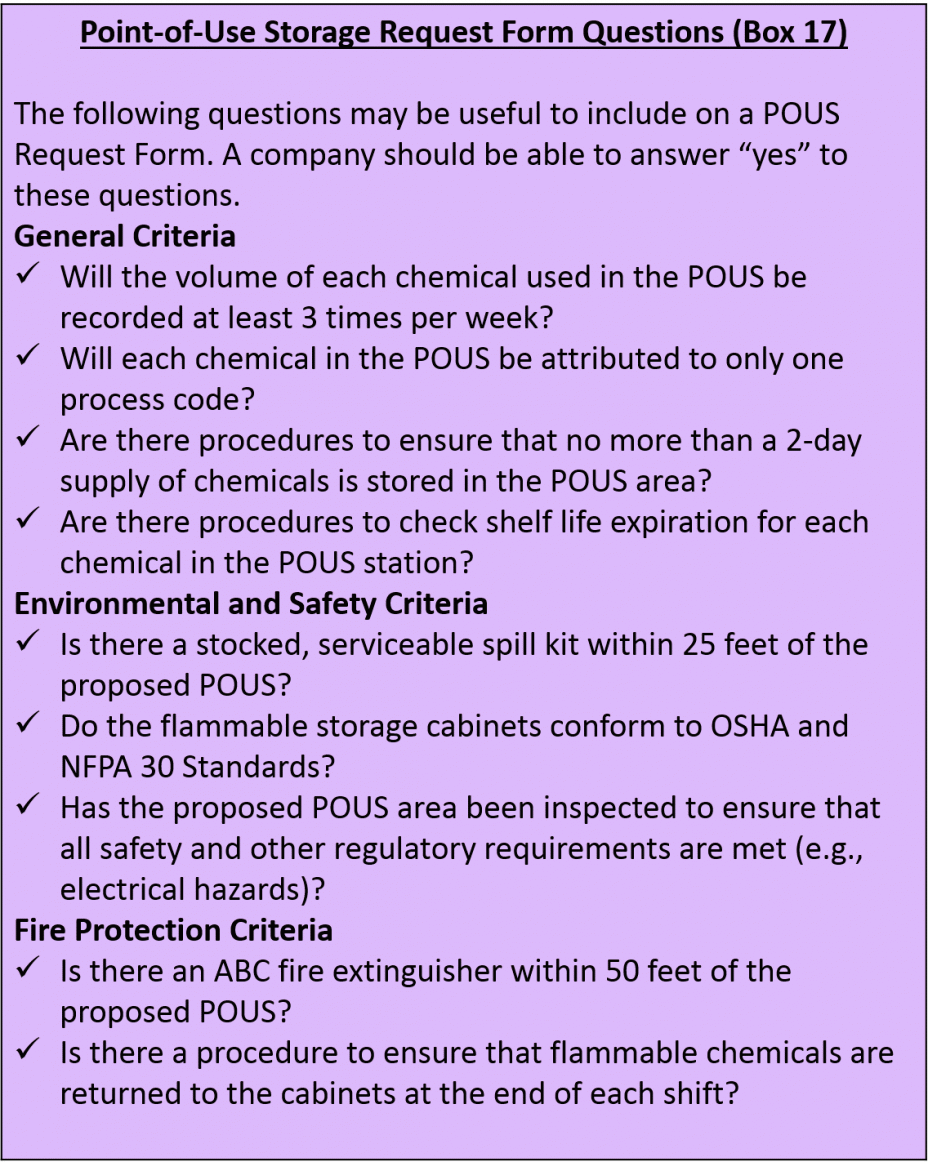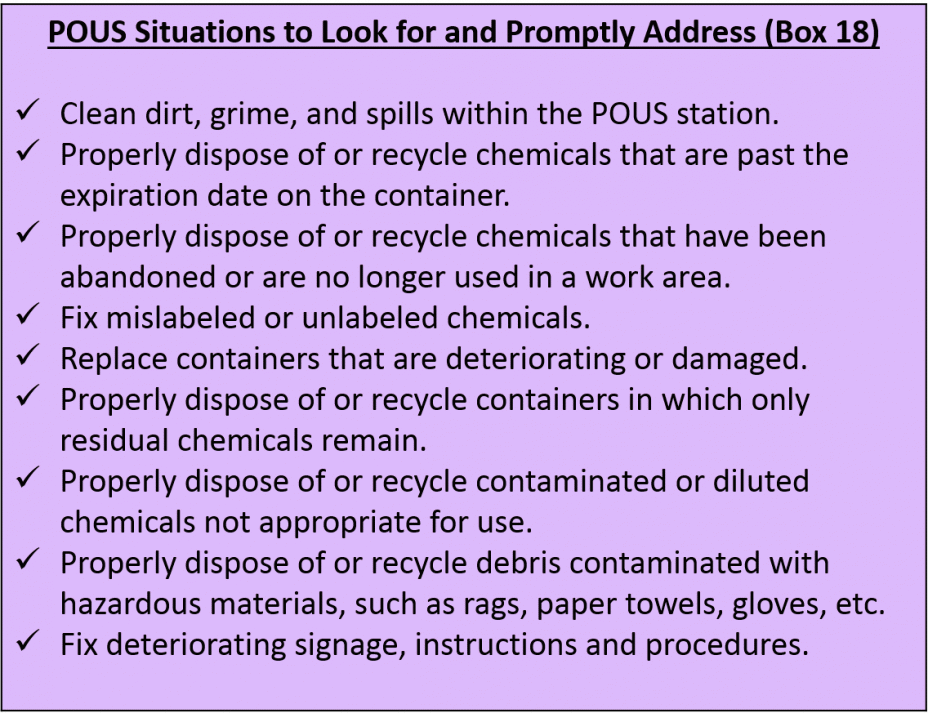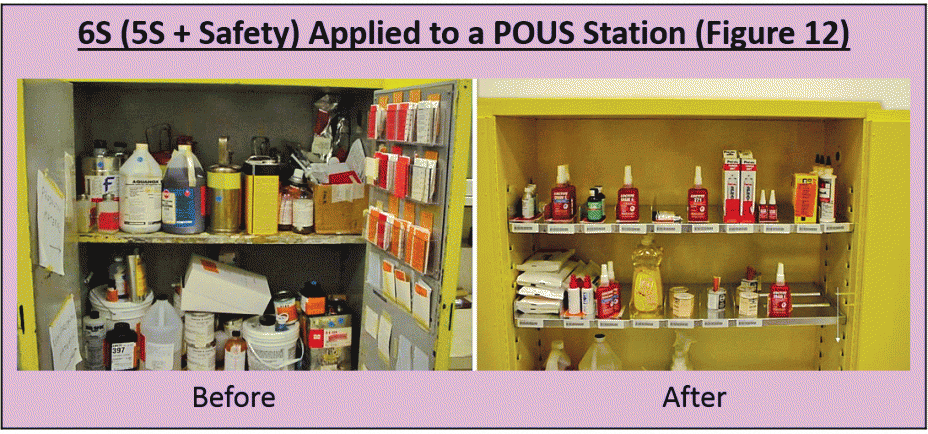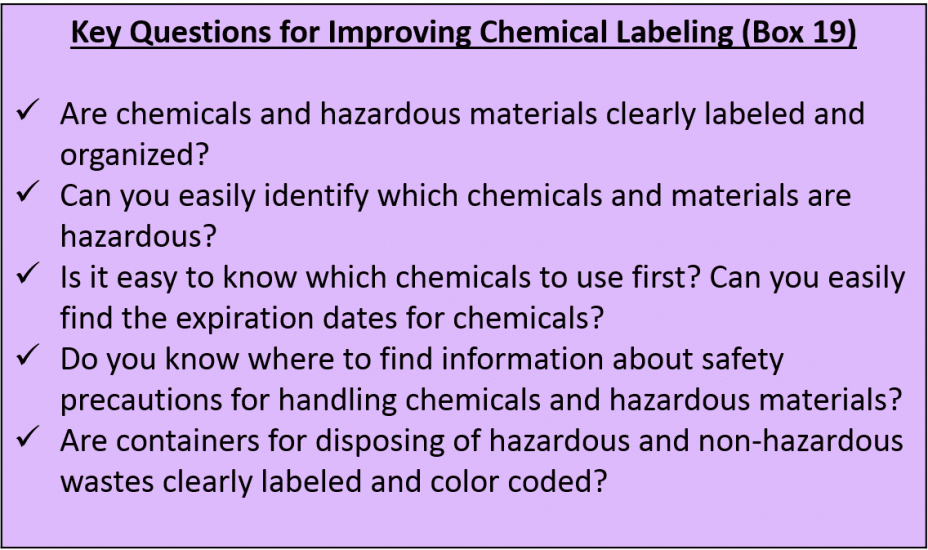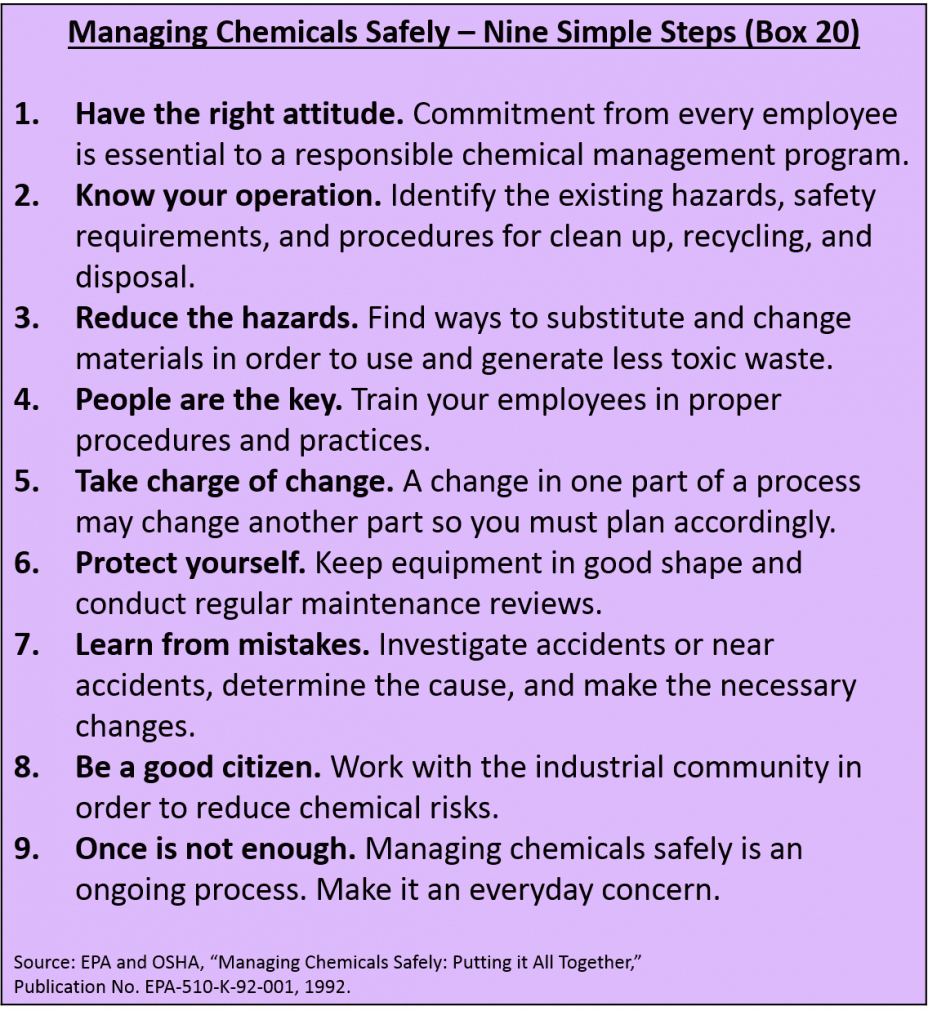Lean & Chemicals Toolkit: Chapter 5
Managing Chemicals in Lean Workspaces
- Point-of-Use Storage (POUS) Best Practices
- Visual Management of Chemicals in the Workplace
- To Consider
- Toolkit Navigation
Point-of-Use Storage Best Practices
POUS chemical management systems can play a powerful role in reducing chemical use and wastes in a Lean workplace. POUS can also create significant challenges for worker health and safety and regulatory compliance without careful and sustained attention. This section discusses several ideas, and best practices, for implementing successful POUS systems that effectively reduce chemical wastes and risk, including POUS approval processes, POUS organization and set-up, and POUS maintenance and housekeeping.
Point-of-Use Storage Approval Processes
![]() The roll-out and expansion of POUS systems involving chemicals must be carefully managed to protect worker health and safety and to avoid regulatory compliance violations. Numerous regulatory requirements may apply to a POUS station, depending on the type and amount of chemicals stored there. Examples of regulatory requirements that may be applicable to POUS stations include:
The roll-out and expansion of POUS systems involving chemicals must be carefully managed to protect worker health and safety and to avoid regulatory compliance violations. Numerous regulatory requirements may apply to a POUS station, depending on the type and amount of chemicals stored there. Examples of regulatory requirements that may be applicable to POUS stations include:
- Emergency Planning and Community Right-to-Know Act (EPCRA) requirements designed to ensure that workers and emergency responders are aware of chemical hazards in the workplace
- Resource Conservation and Recovery Act (RCRA) requirements designed to ensure hazardous wastes are appropriately managed by trained personnel
- Clean Air Act (CAA) air toxics standards and requirements designed to ensure that toxic chemical releases to the air do not adversely affect human health and the environment
- Occupational Safety and Health Administration (OSHA) and National Fire Protection Association (NFPA) requirements to protect worker health and safety from chemical hazards
- Local building and fire code requirements to prevent and contain fires and accidents
![]()
Facility EHS personnel should be involved in the process for reviewing and approving the establishment and siting of new POUS stations and cabinets to ensure that applicable environmental and safety regulatory requirements are identified and addressed. An organization should have a clear policy and set of procedures for requesting and approving the installation of a POUS station or cabinet.
![]() A POUS Request Form can be helpful to establish a clear process for fielding POUS requests and ensuring that applicable requirements are identified and addressed prior to implementation.
A POUS Request Form can be helpful to establish a clear process for fielding POUS requests and ensuring that applicable requirements are identified and addressed prior to implementation.
It can be useful to include the following information on a POUS Request Form:
- Information about the POUS requester
- Information on the party responsible for the POUS station
- The location of desired POUS station
- A list of chemicals that will be kept in the POUS, including relevant chemical numbers and codes, associated work process codes, and quantities/volumes
- A checklist or list of questions to ensure that required procedures are considered and followed (see Box 17 for example questions)
- Routing and signature lines to ensure that appropriate officials have reviewed and approved the request, including individuals responsible for environmental management, worker health and safety, and fire protection
Point-of-Use Storage Set-up and Organization
A point-of-use storage request form can help a facility evaluate whether or not a POUS station or cabinet is appropriate for an area, as well as ![]() identify whether additional safety precautions are needed. Any POUS stations or cabinets should be designed to be well organized, easy to stock and maintain, and clearly labeled. A storage area should only contain items that are useful to tasks that are performed nearby. It is helpful to avoid having too many of any one item; it is better to stock what is needed for a day or two and restock the POUS as needed. This makes it possible to have a wider variety of items in the POUS station or cabinet, and users will waste less time going to look for a chemical or material when it is needed. In addition, consider storing chemicals using a first in, first out (FIFO) system, so that workers use older chemicals first. This can limit the potential for unnecessary expiration of unused, back-of-shelf chemicals.
identify whether additional safety precautions are needed. Any POUS stations or cabinets should be designed to be well organized, easy to stock and maintain, and clearly labeled. A storage area should only contain items that are useful to tasks that are performed nearby. It is helpful to avoid having too many of any one item; it is better to stock what is needed for a day or two and restock the POUS as needed. This makes it possible to have a wider variety of items in the POUS station or cabinet, and users will waste less time going to look for a chemical or material when it is needed. In addition, consider storing chemicals using a first in, first out (FIFO) system, so that workers use older chemicals first. This can limit the potential for unnecessary expiration of unused, back-of-shelf chemicals.
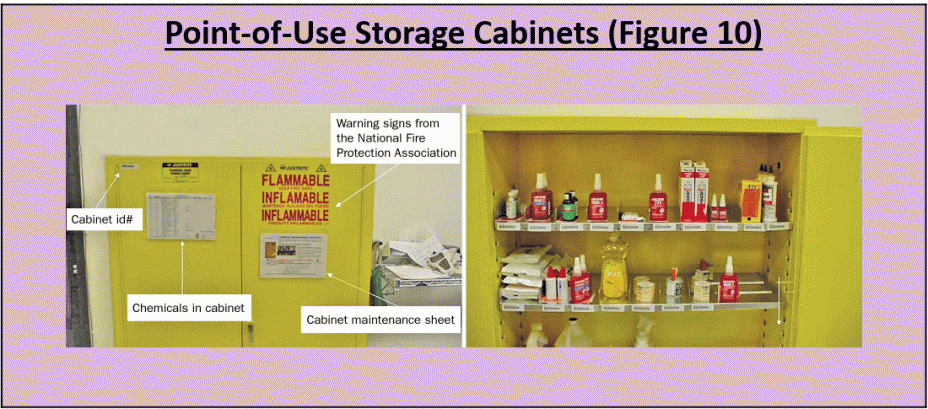 A POUS station or cabinet should be arranged so that the most frequently used items are easiest to access. Figure 9 shows a picture of a POUS Station. One way to ensure this order is maintained is to have a diagram in the storage area showing where items are located. This makes it easy to restock items in the right place so anyone who uses the materials can easily find them. A diagram of the location of supplies can also
A POUS station or cabinet should be arranged so that the most frequently used items are easiest to access. Figure 9 shows a picture of a POUS Station. One way to ensure this order is maintained is to have a diagram in the storage area showing where items are located. This makes it easy to restock items in the right place so anyone who uses the materials can easily find them. A diagram of the location of supplies can also ![]() enable a person using the POUS station for the first time to easily locate an item. A helpful rule of thumb is that anyone should be able to find any item in a POUS station in 30 seconds or less.
enable a person using the POUS station for the first time to easily locate an item. A helpful rule of thumb is that anyone should be able to find any item in a POUS station in 30 seconds or less.
POUS Maintenance and Housekeeping
![]() POUS stations and cabinets should be routinely cleaned, stocked and maintained to ensure that items are in the right place and the station is free of clutter and unnecessary items. Clear policies, procedures, and job expectations should reinforce the role of all employees in maintaining POUS stations in their work areas by putting materials back in the right place and keeping the stations clean and free of trip hazards and other obstructions that can lead to spills.
POUS stations and cabinets should be routinely cleaned, stocked and maintained to ensure that items are in the right place and the station is free of clutter and unnecessary items. Clear policies, procedures, and job expectations should reinforce the role of all employees in maintaining POUS stations in their work areas by putting materials back in the right place and keeping the stations clean and free of trip hazards and other obstructions that can lead to spills.
Other Lean methods discussed in this chapter can help support and reinforce effective cleaning and maintenance of POUS stations. 6S (5S + Safety) can be a powerful Lean method for engaging workers in an area in maintaining and sustaining clean and orderly POUS stations. For example, POUS cleaning and maintenance procedures can be incorporated into 6S (5S + Safety) workplace assessments, shop sweeps and checklists. It may also be appropriate to include POUS cleaning and maintenance activities in standard work procedures for a work area. Box 18 lists several situations that should be routinely checked for and promptly addressed if found. Care should be taken to follow required hazardous waste management practices in situations where it is appropriate to discard chemicals from a POUS station.
![]() Keep in mind that careful attention is needed to ensure that used chemical containers are properly reused, recycled, or disposed. Look for opportunities to prevent used containers from adding to your organization’s hazardous waste stream. It may be possible to clean and reuse or recycle used chemical containers. Consult your facility’s EHS personnel for guidance on appropriate practices.
Keep in mind that careful attention is needed to ensure that used chemical containers are properly reused, recycled, or disposed. Look for opportunities to prevent used containers from adding to your organization’s hazardous waste stream. It may be possible to clean and reuse or recycle used chemical containers. Consult your facility’s EHS personnel for guidance on appropriate practices.
Visual Management of Chemicals in the Workplace
Common Lean visual management tools, such as 6S (5S + Safety), visual controls, standard work, and TPM, can be used to make it easier for employees to manage chemicals and hazardous waste in their workspace.
6S (5S + Safety) and Chemical Management
![]() 6S, or 5S + Safety, is a method used to create and maintain a clean, orderly, and safe work environment. 6S is based upon the five pillars (5S) of the visual workplace in the Toyota Production System, plus an overall pillar for safety. Each of the 6S pillars is relevant to chemical management. Specific linkages are summarized below:
6S, or 5S + Safety, is a method used to create and maintain a clean, orderly, and safe work environment. 6S is based upon the five pillars (5S) of the visual workplace in the Toyota Production System, plus an overall pillar for safety. Each of the 6S pillars is relevant to chemical management. Specific linkages are summarized below:
- Safety (Respect workplace and employee): Create a safe place to work that is free of chemical hazards.
- Sort (Get rid of it): Separate out and eliminate chemicals that are not needed in the work area.
- Set in order (Organize): Organize the chemicals that remain in the work area.
- Shine (Clean and solve): Clean and inspect areas where chemicals are stored, used, and disposed.
- Standardize (Make consistent): Standardize cleaning, inspection, and safety practices related to chemical management activities and locations.
- Sustain (Keep it up): Make sure that chemical management procedures become part of standard work, that problems are quickly addressed, and that systems are routinely assessed for improvement opportunities.
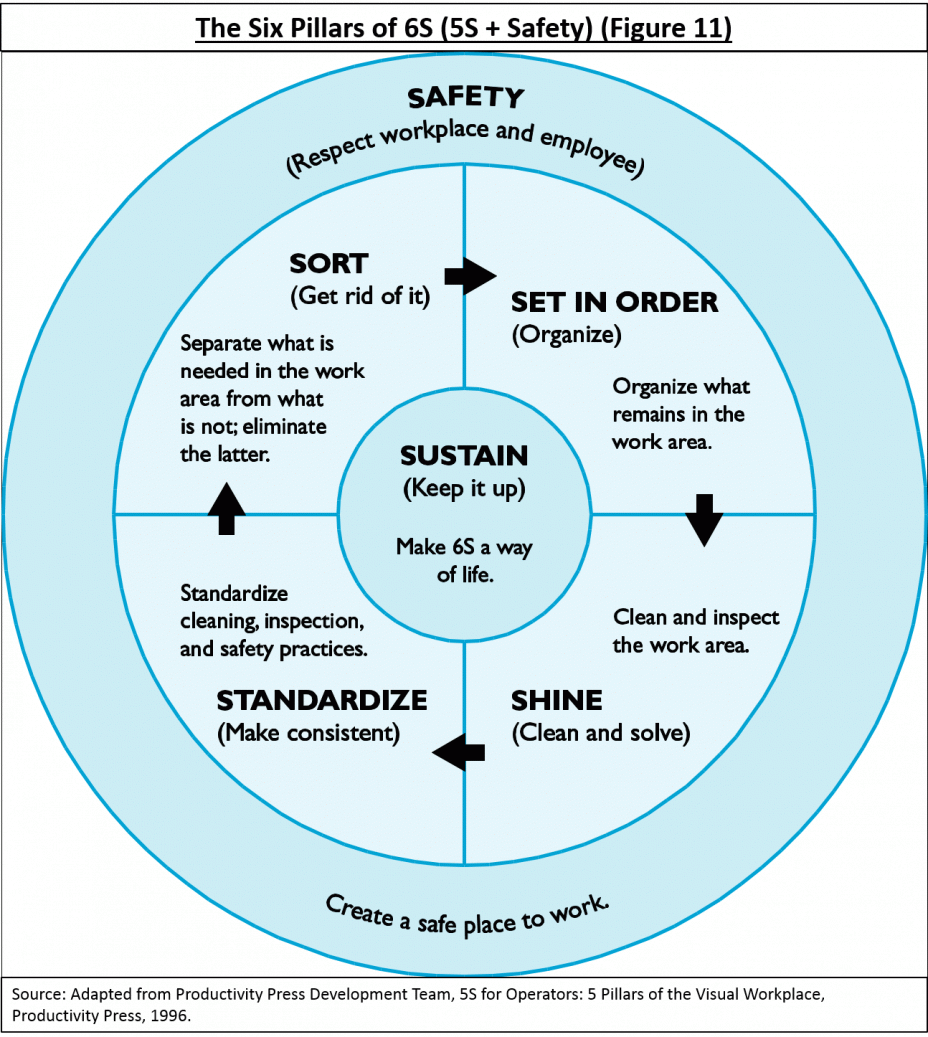 The before and after photos shown in Figure 12 illustrate how the 6S pillars can be applied to transform a POUS station.
The before and after photos shown in Figure 12 illustrate how the 6S pillars can be applied to transform a POUS station.
It is important to remember that when unnecessary chemicals and substances are discovered in the workplace during a 6S event, they should be ![]() carefully and properly managed and disposed of to protect worker safety and to ensure compliance with applicable environmental and safety regulations. EPA’s Lean and Environment Toolkit discusses how red-tagging can be used during 6S events to flag unneeded chemicals and hazardous wastes. EHS professionals should be contacted to ensure that proper handling and disposal procedures are followed.
carefully and properly managed and disposed of to protect worker safety and to ensure compliance with applicable environmental and safety regulations. EPA’s Lean and Environment Toolkit discusses how red-tagging can be used during 6S events to flag unneeded chemicals and hazardous wastes. EHS professionals should be contacted to ensure that proper handling and disposal procedures are followed.
Visual Controls, Standard Work and Chemical Management
![]() Visual controls are used to reinforce standardized procedures and to display the status of an activity so every employee can see it and take appropriate action. Visual controls can help make sure employees are aware of chemical hazards and are equipped to take appropriate action to handle and manage chemicals appropriately. As discussed in the Point-of-Use Storage Set-up and Organization section above, visual controls can be particularly useful in organizing POUS stations and hazardous waste accumulation and management areas.
Visual controls are used to reinforce standardized procedures and to display the status of an activity so every employee can see it and take appropriate action. Visual controls can help make sure employees are aware of chemical hazards and are equipped to take appropriate action to handle and manage chemicals appropriately. As discussed in the Point-of-Use Storage Set-up and Organization section above, visual controls can be particularly useful in organizing POUS stations and hazardous waste accumulation and management areas.
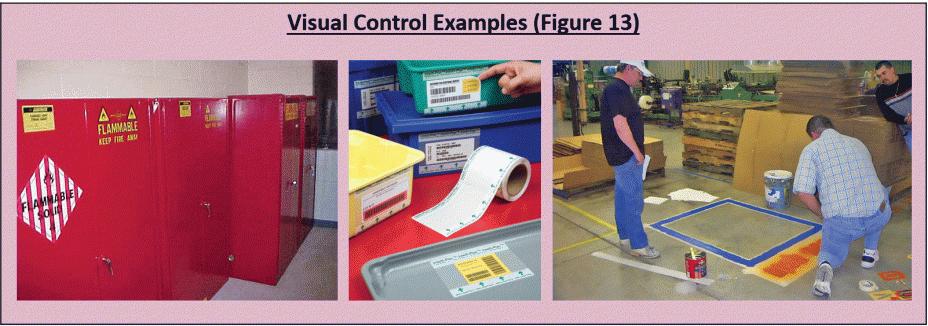 Areas for storing, using and transporting chemicals can also be clearly marked with lines on the floor and signs and placards on walls or hanging from the ceiling to ensure workers see visual cues to remind them of locations where chemicals and hazardous wastes are managed or stored.
Areas for storing, using and transporting chemicals can also be clearly marked with lines on the floor and signs and placards on walls or hanging from the ceiling to ensure workers see visual cues to remind them of locations where chemicals and hazardous wastes are managed or stored.
Visual controls can also be used for minor tasks, such as helping employees know how much chemical remains in a container or to know how much chemical to put into equipment or a tank. For example, clear containers can make it easy to see the amount of chemicals that remain. Color-coded marking in a tank or tub can assist workers in adding the right amount of chemicals to a process step or piece of equipment.
![]() Standard work can also be used to ensure that appropriate chemical management practices become part of routine work practices. Standard work refers to an agreed-upon set of work procedures that establish the best and most reliable method of performing a task or operation. Standard work is the final stage of Lean implementation in that it helps sustain previous Lean improvements and serves as the foundation for future continuous improvement (kaizen) efforts.
Standard work can also be used to ensure that appropriate chemical management practices become part of routine work practices. Standard work refers to an agreed-upon set of work procedures that establish the best and most reliable method of performing a task or operation. Standard work is the final stage of Lean implementation in that it helps sustain previous Lean improvements and serves as the foundation for future continuous improvement (kaizen) efforts.
![]() Standard work for a manufacturing cell or Lean workspace should include all actions needed to appropriately manage, use, and dispose of chemicals in the area. If chemical management procedures sit on the shelf in a separate place, they will rarely become part of routine work practice. If chemical management procedures are distinct, such as those related to maintenance of a POUS station, they should be treated like other standard work and made available in the work area for easy reference. Many organizations laminate standard work procedures and hang them in a work station for easy reference.
Standard work for a manufacturing cell or Lean workspace should include all actions needed to appropriately manage, use, and dispose of chemicals in the area. If chemical management procedures sit on the shelf in a separate place, they will rarely become part of routine work practice. If chemical management procedures are distinct, such as those related to maintenance of a POUS station, they should be treated like other standard work and made available in the work area for easy reference. Many organizations laminate standard work procedures and hang them in a work station for easy reference.
It may also be useful to code a chemical management standard work step or procedure with an icon (such as a red safety cross or green tree) or number for easy reference back to the organization’s Environmental Management System (EMS) or compliance management system.
Total Productive Maintenance and Chemical Management
![]() Total Productive Maintenance (TPM) is also relevant to chemical management and waste elimination. TPM is a Lean method that focuses on optimizing the effectiveness of manufacturing equipment. TPM builds upon established equipment-management approaches and focuses on team-based maintenance that involves employees at every level and function.
Total Productive Maintenance (TPM) is also relevant to chemical management and waste elimination. TPM is a Lean method that focuses on optimizing the effectiveness of manufacturing equipment. TPM builds upon established equipment-management approaches and focuses on team-based maintenance that involves employees at every level and function.
A key practice in TPM is to maintain equipment and machines in a manner that enables workers to quickly identify and correct problems that may result in leaks or spills of chemicals. Effective routine maintenance may also reduce the amount of chemicals, such as lubricants or solvents, needed to operate equipment.
Box 20 describes several simple steps for safely managing chemicals. These steps fit well with Lean principles such as employee engagement, waste elimination, and continual improvement. Consider integrating these principles into your organization’s use of Lean methods such as standard work, TPM, 6S (5S + Safety), and Lean process improvement events.
Toolkit Navigation
- Contents & Acknowledgements
- Executive Summary
- Preface
- Chapter 1: Introduction
- Chapter 2: Chemicals Overview
- Chapter 3: Driving Out Chemical Waste with Lean Events
- Chapter 4: Chemical Management in the Lean Organization
- Chapter 5: Managing Chemicals in Lean Workspaces
- Chapter 6: Lean Product and Process Design Methods
- Chapter 7: Conclusion
- Appendix A: Chemical Resources
- Appendix B: Material Safety Data Sheet Template Example
- Appendix C: Point-of-Use Storage Request Form Example

